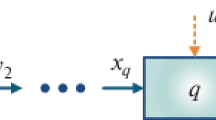Abstract
Heat exchanger network (HEN) synthesis has been a well-studied subject over the past decades. Many studies and methodologies were proposed to make possible the energy recovery, minimizing the utilities consumption and the number of heat transfer equipment.
Most of papers published in this subject are based on Pinch Analysis and mathematical programming. Some recent papers use meta-heuristic techniques like Genetic Algorithms or Simulated Annealing to solve the HEN synthesis problem and good results are found but with large computational effort.
In this paper an optimization model for the synthesis of HEN is proposed. The approach is based on the use of Particle Swarm Optimization to determine the HEN that minimizes the total annualized cost, accounting for capital costs of heat exchangers and the energy costs for utilities and pumping duties. The algorithm is based on a superstructure simultaneous optimization model for the HEN synthesis considering stream splitting. Some examples from the literature were used to show the application of the proposed algorithm, and the results confirm the achievement of the optimum HEN configuration with little computational effort.
Similar content being viewed by others
References
Ahmad S (1985) Heat exchanger networks: cost tradeoffs in energy and capital. Tese de D.Sc., Faculty of Technology, University of Manchester Institute of Science and Technology, Manchester
Bjork K, Westerlund T (2002) Global optimization for heat exchanger network synthesis problems with and without the isothermal mixing assumption. Comput Chem Eng 26:1581–1593
Castillo E, Acevedo L, Reververi A (1998) Cleaner production of nitric acid by heat transfer optimization: a case study. Chem Biochem Eng 12:157–165
Cerda J, Westerberg AW (1983) Synthesizing heat exchanger networks having restricted stream/stream matches using transportation problem formulation. Chem Eng Sci 38:1723
Ciric AR, Floudas CA (1991) Heat exchanger network synthesis without decomposition. Comput Chem Eng 15:385–396
Colberg RD, Morari M (1990) Area and capital cost targets for heat exchanger network synthesis with constrained matches and unequal heat transfer coefficients. Comput Chem Eng 14:1
Daichendt MM, Grossmann IE (1994) A preliminary screening procedure for MINLP heat exchanger network synthesis using aggregated models. Chem Eng Res Des 72:357–363
Floudas CA, Ciric AR, Grossmann IE (1986) Automatic synthesis of optimum heat exchanger network configurations. AIChE J 32:276
Furman KC, Sahinidis NV (2002) A critical review and annotated bibliography for heat exchanger network synthesis in the 20th century. Ind Eng Chem Res 41:2335–2370
Grossmann IE, Caballero JA, Yeomans H (2000) Advances in mathematical programming for the synthesis of process systems. Lat Am Appl Res 30:263–284
Gundersen T, Grossmann IE (1990) Improved optimization strategies for automated heat exchanger network synthesis through physical insights. Comput Chem Eng 14:925
Gundersen T, Naess L (1998) The synthesis of cost optimal heat exchanger networks—An industrial review of the state of the art. Comput Chem Eng 126:503–530
Kennedy J, Eberhart R (2001) Swarm intelligence. Academic Press, London
Lee S, Grossmann IE (2000) New algorithms for non-linear generalized disjunctive programming. Comput Chem Eng 24:2125–2141
Linnhoff B (1993) Pinch analysis: A state-of-the-art overview. Trans IChemE, Part A 71:503–522
Linnhoff B (1994) Use pinch analysis to knock down capital costs and emissions. Chem Eng Prog 32–57
Linnhoff B, Flower J (1978) Synthesis of heat exchanger networks. I. Systematic generation of energy optimal networks. AIChE J 244:633–642
Linnhoff B, Hindmarsh E (1983) The pinch design method for heat exchanger networks. Chem Eng Sci 38:745–763
Linnhoff B, Mason DR, Wardle I (1979) Understanding heat exchanger networks. Comput Chem Eng 3:295–302
Linnhoff B, Towsend DW, Boland D, Hewitt GF, Thomas BEA, Guy AR, Marsland RH (1982) A user guide on process integration for the efficient use of energy. The Institute of Chemical Engineers
Papulias SA, Grossmann IE (1983) A structural optimization approach in process synthesis. Part II. Heat recovery networks. Comput Chem Eng 7:707
Quesada IE, Grossmann IE (1993) Global optimization algorithm for heat exchanger networks. Ind Eng Chem Res 32:487
Raman R, Grossmann IE (1994) Modeling and computational techniques for logic based integer programming. Comput Chem Eng 18:563–568
Ravagnani MASS, Caballero JA (2007) Optimal heat exchanger network synthesis with the detailed heat transfer equipment design. Comput Chem Eng 31:1432–1448
Ravagnani MASS, Silva AP, Andrade AL (2003) Detailed equipment design in heat exchanger networks synthesis and optimization. Appl Thermal Anal 23:141–151
Turkay M, Grossmann IE (1996) Logic-based MINLP algorithms for the optimal synthesis of process networks. Comput Chem Eng 208:959–978
Vieira RC, Biscaia EC Jr (2002) Métodos heurísticos de otimização. Notas de aula da escola piloto virtual Do Peq/Coppe/Ufrj. Available under consultation: biscaia@peq.coppe.ufrj.br
Yee TF, Grossmann IE (1990) Simultaneous optimization models for heat integration. II. Heat exchanger network synthesis. Comput Chem Eng 14:1165
Zamora J, Grossmann IE (1998) A global optimization algorithm for the synthesis of heat exchanger networks with no stream splits. Comput Chem Eng 22:367–384
Zhu X (1997) Automated design method for heat exchanger network synthesis using block decomposition and heuristic rules. Comput Chem Eng 21:1095–1104
Author information
Authors and Affiliations
Corresponding author
Rights and permissions
About this article
Cite this article
Silva, A.P., Ravagnani, M.A.S.S., Biscaia, E.C. et al. Optimal heat exchanger network synthesis using particle swarm optimization. Optim Eng 11, 459–470 (2010). https://doi.org/10.1007/s11081-009-9089-z
Received:
Accepted:
Published:
Issue Date:
DOI: https://doi.org/10.1007/s11081-009-9089-z




